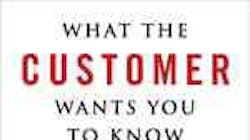The heart of the new approach to selling is an intense focus on the prosperity of your customers. This is a radical departure from what most salespeople and selling organizations do. The entire psychological orientation is shifted 180 degrees. No longer do you measure your own success first. Instead, you measure success by how well your customers are doing with your help. You're not focused on selling a specific product or service; you're focused on how your company can help the customer succeed in all the ways that are important to that customer. By tapping the many resources you have at your disposal to help customers meet their business goals and priorities, you are adding value.
This ability to create value for customers will differentiate you in a crowded marketplace, and you will be paid a fair price for it -- one that is commensurate with the value customers perceive they are getting and the value you do in fact provide. I call this new approach value creation selling, or VCS.
Value creation selling is sweepingly different from how most companies sell today, in these ways:
First, you as a seller and your organization devote large amounts of quality time and energy -- much more than you do today -- to learning about your customers' businesses in great detail. What are your customer's goals? Which financial measures is he most keen about? How does he create market value and what are the key factors that differentiate his product or service from those of his competitors? Only then do you look for ways to help the customer in the short, medium, and long term. The greatest opportunities lie in the medium and long term, where you and your customer can work together to change the nature of the game in your customer's industry based on value you can help provide.
Second, you use capabilities and tools that you've never used before to understand how your customers do business and how you can help them improve that business. Sales is no longer just for the sales force: you need to muster the help of people in many parts of your company to do that. People from many different departments, including the legal, finance, R&D, marketing and manufacturing, become intimately familiar with your customer. You compile large amounts of information about your customer, both facts and impressions, in useful databases that are shared and used to determine the best approach for helping your customer win.
This will demand that you build new social networks, both within your organization and between your organization and the customer's shop. Information will have to flow in both directions, and there will be a need for frequent formal and informal interaction among people serving different functions within your company and between your company and the customer's. For example, your engineering people will need to meet with the people in your customer's shop who define the specifications of your customer's products or services.
Fourth, you have to recognize that the execution of this new approach will require much longer cycle times to produce an order and generate revenue. It requires patience, consistency, and a determination on your part to build a high degree of trust with your customers. This is imperative because in this new relationship the two-way information exchange is far deeper than what you have relied on in the past. But once it gets going, the cycle time can be very fast, because you will have established trust and credibility.
Finally, top management in your company will have to reengineer its recognition and reward system to make sure that the organization as a whole is fostering the behaviors that will make the new sales approach effective. Hitting quarterly sales targets is not the only basis for rewarding the sales force under this approach. Further, other members of the sales team from various functional areas must be recognized and rewarded proportionately for their contributions. If after receiving sufficient training and support the salespeople or other functional executives don't adopt the new approach with wholehearted enthusiasm, you will have to replace some people.
Ram Charan is the author or coauthor of many bestselling business books, including What the CEO Wants You to Know and Execution. For more than thirty-five years, he has worked behind the scenes at Fortune 100 companies like GE, Bank of America, DuPont, Thomson financial, Honeywell and Home Depot to help senior executives develop and implement strategic plans. www.ram-charan.com
Interested in information related to this topic? Subscribe to our weekly Value-chain eNewsletter.
